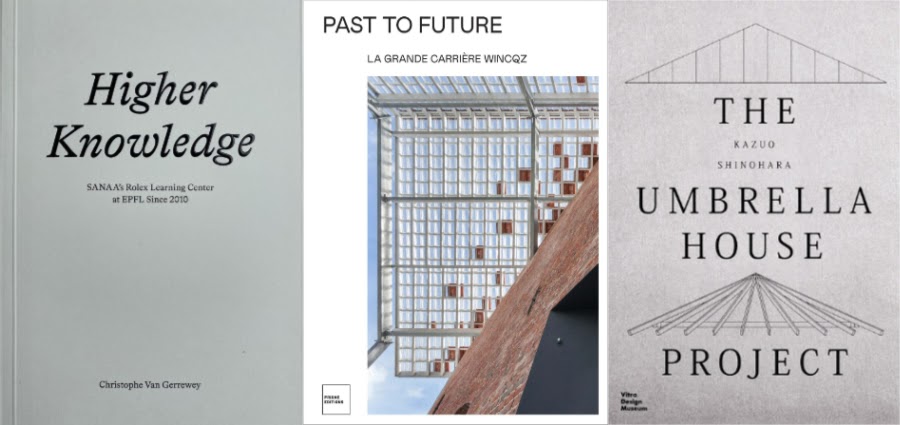On Case Studies
"What is a case study?" you might be asking, or maybe, "Is it different than a monograph?" Although the word monograph literally applies to any book devoted to any individual subject — be it a person, a place, a thing, or even an idea — in the realm of architecture books that one-word term is used more prevalently, if not strictly, in regards to individual architects and/or firms. A book on Le Corbusier is a monograph. A book on Villa Savoye is a case study. Although I opted to have two chapters in my book Buildings in Print titled monographs — "Monographs (Architects)" and "Monographs (Buildings)" — I still prefer to call books devoted to buildings and other individual works (landscapes, artworks, books, etc.) as "case studies." I like how the phrase indicates that the subject, the case, is being analyzed in depth: it is being studied, not just presented. Ideally, a case study delves into the meaning and other aspects of a building rather than just documenting it. Buildings take years to realize, some even take decades, and that fact alone points to them deserving in-depth book-length treatments. Granted, not all buildings should have a book devoted to them, but definitely more than have been given the case-study treatment.The fact I included a case study chapter in Buildings in Print, as mentioned above, points to my appreciation of this sub-genre of architecture books but also to the role they have played in teaching architecture students, spreading knowledge around important works, and promoting architects and architecture within and beyond the profession. Perhaps the most well known case studies are from Phaidon's "Architecture in Detail" series from the 1990s, when a few-dozen buildings were documented in photographs, drawings, and critical essays. The books were slim but the pages were large (12" square, though smaller editions were later released for some of the titles), which made the detailed drawings particularly helpful for students and practicing architects. Among many others, the case studies included Frank Lloyd Wright's Fallingwater, Alvar Aalto's Villa Mairea, and the Eames House by Charles and Ray Eames; those three titles were later bound into one hardcover as part of Phaidon's repackaging of the series as "Architecture 3s." There have been other case study series, though very few continue to publish; only "Opus" from Edition Axel Menges and the "O'Neil Ford Monograph Series" from UTA come to mind as appearing to have ongoing momentum. I hope there are others.I have more than a hundred books in my library that I consider case studies, ranging from pocket-size books to coffee table books, both architecture and other subjects. Among them are a slim analysis of the film Groundhog Day, a "reader's guide" to Haruki Murakami's The Wind-Up Bird Chronicle, Michael Benedikt's classic Deconstructing the Kimbell: An Essay on Meaning and Architecture, a small book on WORKac's MoMA PS1 pavilion, the huge Diller Scofidio + Renfro: Lincoln Center Inside Out: An Architectural Account, my souvenir from a trip to Peter Zumthor's Therme Vals, and a beautiful book on Geoffrey Bawa's Lunuganga, a place I'll probably never see in person. This short list indicates that case studies are just as often critical takes as they are first-person accounts of the making of something. They can serve as vehicles for exploring ideas, as in Benedikt's book on the Kimbell; they can serve as repositories for the many sketches, drawings, and photographs produced about a place; or they can exist somewhere in between on such a spectrum between critical analysis and laudatory presentation. My favorites tend toward the last: an abundance of visual information accompanied by input from both creators and critics. Three recently published books have me considering case studies:Higher Knowledge: SANAA'S Rolex Learning Center at EPFL Since 2010 by Christophe Van Gerrewey, published by EPFL Press, 2022 (Amazon / Bookshop)Past to Future: La Grande Carrière Wincqz by Isabelle Toussaint and Matteo Robbiglio with photographs by Marie Noëlle Dailly, published by Prisme Editions, 2022 (Amazon)Kazuo Shinohara: The Umbrella House Project edited by Christian Dehli and Andrea Grolimund, published by Vitra Design Museum, 2023 (Amazon / Bookshop)The first, Christophe Van Gerrewey's essay on SANAA'S Rolex Learning Center at EPFL Lausanne (École polytechnique fédérale de Lausanne, or Swiss Federal Institute of Technology Lausanne), falls into the critical-analysis camp. It is less than 100 pages, has a fairly large text size for such small pages, and has quite a few b/w photographs. It is a quick read, in other words, but it is not short on ideas. Van Gerrewey explores a myriad aspects of the distinctive undulating building completed in 2010 (the same year Kazuyo Sejima and Ryue Nishizawa won the Pritzker Prize): from the campus's origins and the building's programmatic requirements, to situating the project's flowing spaces within other open-plan b

Three recently published books have me considering case studies:
- Higher Knowledge: SANAA'S Rolex Learning Center at EPFL Since 2010 by Christophe Van Gerrewey, published by EPFL Press, 2022 (Amazon / Bookshop)
- Past to Future: La Grande Carrière Wincqz by Isabelle Toussaint and Matteo Robbiglio with photographs by Marie Noëlle Dailly, published by Prisme Editions, 2022 (Amazon)
- Kazuo Shinohara: The Umbrella House Project edited by Christian Dehli and Andrea Grolimund, published by Vitra Design Museum, 2023 (Amazon / Bookshop)

